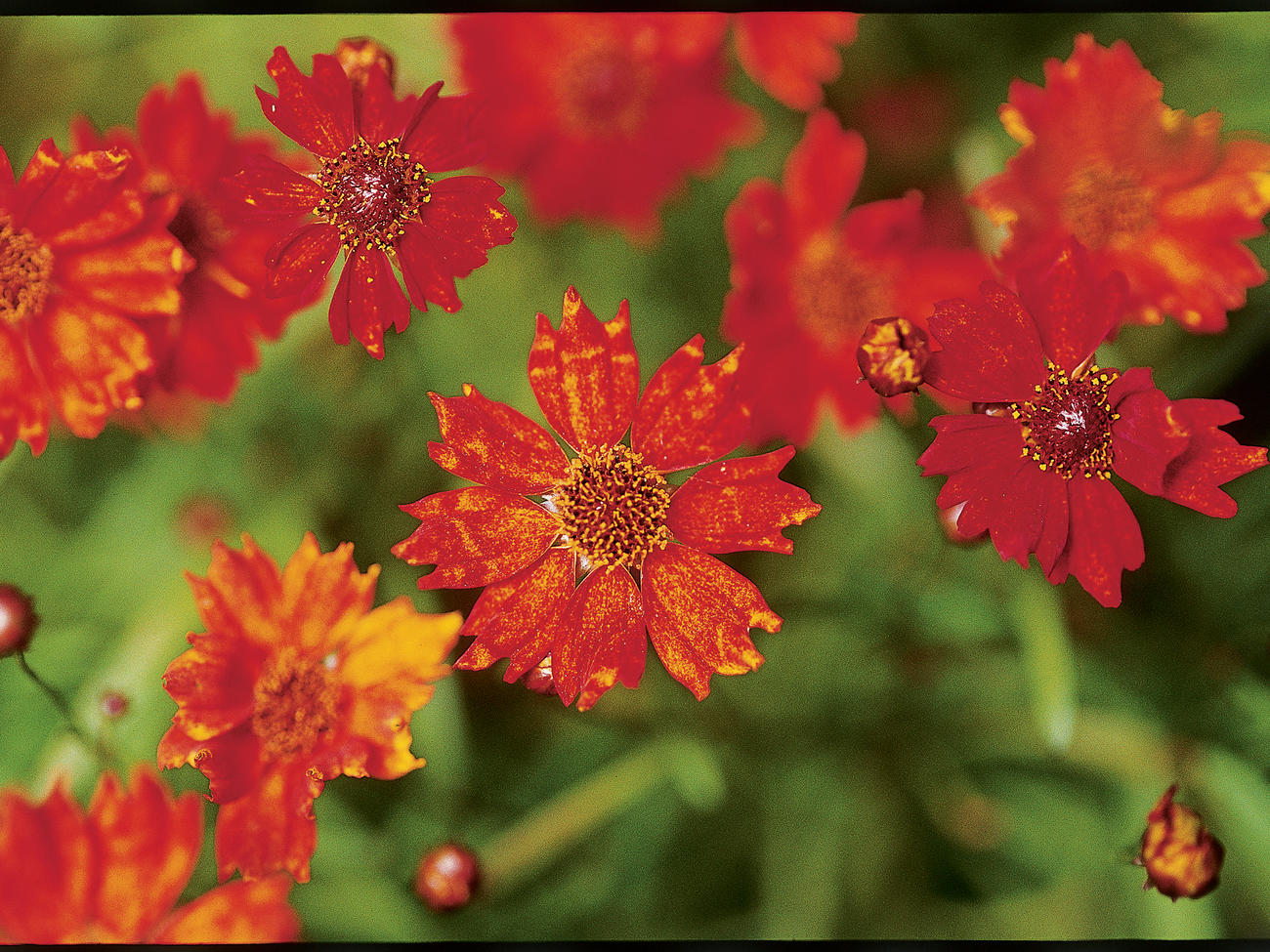
Waterwise Plants

UNTHIRSTY COLOR
Aster. A. x frikartii ‘Mönch’, a perennial, bears lavender-blue flowers early summer to fall on 2-foot plants. Sunset climate zones 2b–24.
Coreopsis. Perennial. C. verticillata has yellow, daisylike blooms; ‘Moonbeam’ has pale yellow blooms, grows 2 to 3 feet tall. Zones 1–24. C. tinctoria is an annual to 3 feet tall.
Gaillardia x grandiflora. Daisylike flowers in golden yellows, reds, and bicolors. Grows 2 to 4 feet tall. Zones 1–24, H1, H2.
Garden penstemon. (P. x gloxinioides). Many kinds and colors bloom most heavily in spring. Firecracker red, deep purple, or pale pink flower spikes, depending on variety. Plants grow 2 to 4 feet tall. Perennial in zones 6–9, 14–24; annual elsewhere.
Purple coneflower (Echinacea purpurea). Lavender-pink, daisylike blooms with bristly, mounding centers. ‘Magnus’ grows 4 feet tall. Zones 1–3, 10–13.
Rudbeckia. R. fulgida ‘Goldsturm’ bears golden yellow blooms on 3-foot-tall plants. R. hirta (winter annual in zones 12–13) grows 3 to 4 feet tall; yellow blooms. Zones 1–24.
Sneezeweed (Helenium hybrids). Red and orange flowers. ‘Moerheim Beauty’ is coppery red. Grows 3 to 5 feet tall. Zones 1–24.
Sunrose (Helianthemum nummularium). Flowers in a range of colors, from flame red, orange, and yellow to peach, pink, and white. Let plants tumble over rocks or spill from niches in dry rock walls. Needs good drainage. Grows 6 to 8 inches tall, spreads to 3 feet. Zones 2b–9, 14–24.
Verbena. Tapien hybrids grow 4 inches tall, spread 1 to 1 1/2 feet wide; colors range from deep purple and pale blue to pink; late spring to fall. Perennial in zones 4–9, 12–24, H1–H2. V. lilacina ‘De La Mina’ forms a 3-foot mound, with deep purple flowers spring to fall. Perennial in zones 12–24.
Yarrow (Achillea). Flower colors include salmon and rusty red. A. filipendulina ‘Coronation Gold’ has yellow blooms. Grows 4 feet tall. Zones A1–A3, 1–24.
Zauschneria californica latifolia ‘Arizonica’. Mounding plant to 3 feet tall; bright orange flowers. Zones 2-11, 14-24.
UNTHIRSTY TEXTURE
Catmint (Nepeta x faassenii). Mounding lavender-blue perennial 1 foot tall, 1 foot wide. Zones 1–24.
Kangaroo paw (Anigozanthos). A. flavidus has branching stems to 5 feet tall in clumps 2 to 3 feet wide; yellow-green flowers. Smaller hybrids, with flowers in a range of colors, grow 1 1/2 to 3 feet tall. Needs excellent drainage. Zones 15–24.
Russian sage (Perovskia). Velvety, lavender-blue flowers on plants 3 to 4 feet tall and wide. Zones 2–24.
Santolina. Two kinds; both have small buttonhead flowers. S. rosmarinifolia has green foliage, yellow flowers; zones 3–9, 14–24. S. chamaecyparissus has whitish gray leaves, yellow flowers; zones 2–24, H1, H2. Both grow 2 feet tall, 3 feet wide.
Sea lavender (Limonium perezii). To 3 feet tall, with rich purple blooms spring and summer. Zones 13, 15–17, 20–24. Good near the beach; needs afternoon shade in the desert.
Thyme. Creeping thyme (Thymus serpyllum) grows about 3 inches high, 3 feet wide; purplish summer flowers; zones A2, A3, 1–24. Common thyme (T. vulgaris) grows 1 foot high, 2 feet wide; white to lilac flowers in late spring, early summer; zones 1–24.
UNTHIRSTY FRAGRANCE
Butterfly bush (Buddleja davidii). Semievergreen or deciduous shrub with clusters of lightly scented, small lavender flowers on plants 6 feet tall or taller. Needs good drainage. Zones 2–24, H1.
Chinese wisteria (W. sinensis). Woody vine with lacy green foliage and clusters of fragrant blue-violet flowers. Zones 3–24.
Lavender. Many kinds have classic lavender scent. English lavender (Lavandula angustifolia), which grows to 3 1/2 feet tall and 3 feet wide, is among the most fragrant. Smaller ‘Hidcote’ and ‘Munstead’ grow to 2 feet tall. Zones 2–24.
Rosemary (Rosmarinus). Aromatic green leaves with grayish white undersides grow on woody stems. ‘Prostratus’ grows to 2 feet tall with a 4-foot spread; can trail straight down a wall. Perennial in zones 4–24, H1, H2.
Drought Strategies
- Limit turf. It needs more water than most other plants.
- Group plants with similar water needs. If plants that need to be watered at the same frequency and for the same length of time are all in one place, you can dedicate a separate line or valve to them, delivering exactly the amount of water the plants need and no more.
- Irrigate efficiently. Match the system―whether drip irrigation, sprinklers, or soaker hoses―to the situation, the soil, and the plants.
- Plant trees. Trees shade the ground beneath, lowering air temperatures and reducing moisture loss.
- Improve soil. Dig organic amendments into the soil to help its texture.
- Add mulch. Cover soil with a 3- to 5-inch layer of mulch to help conserve water by reducing evaporation.
